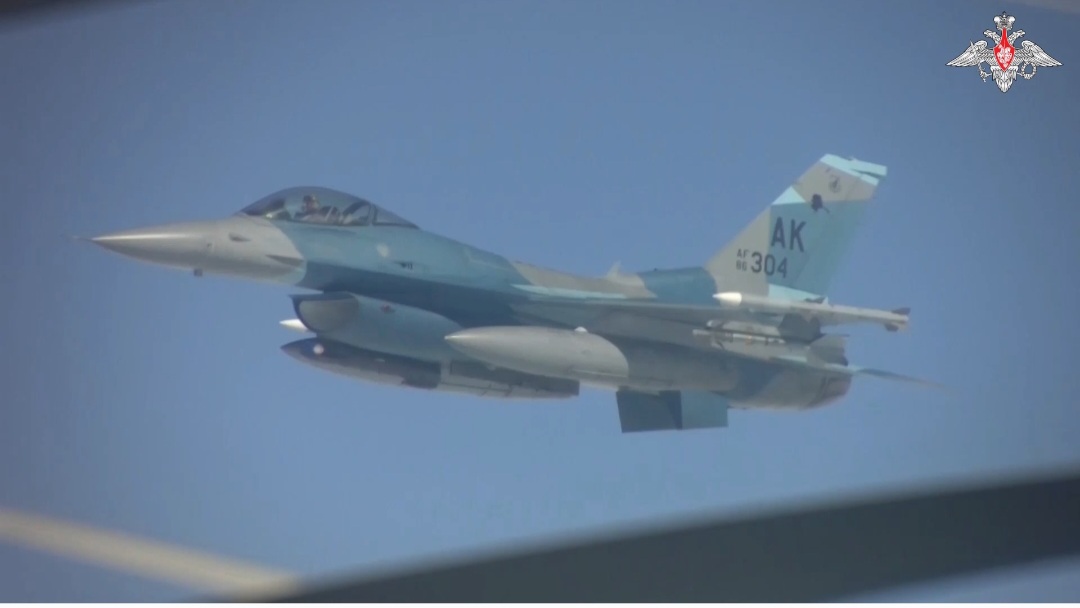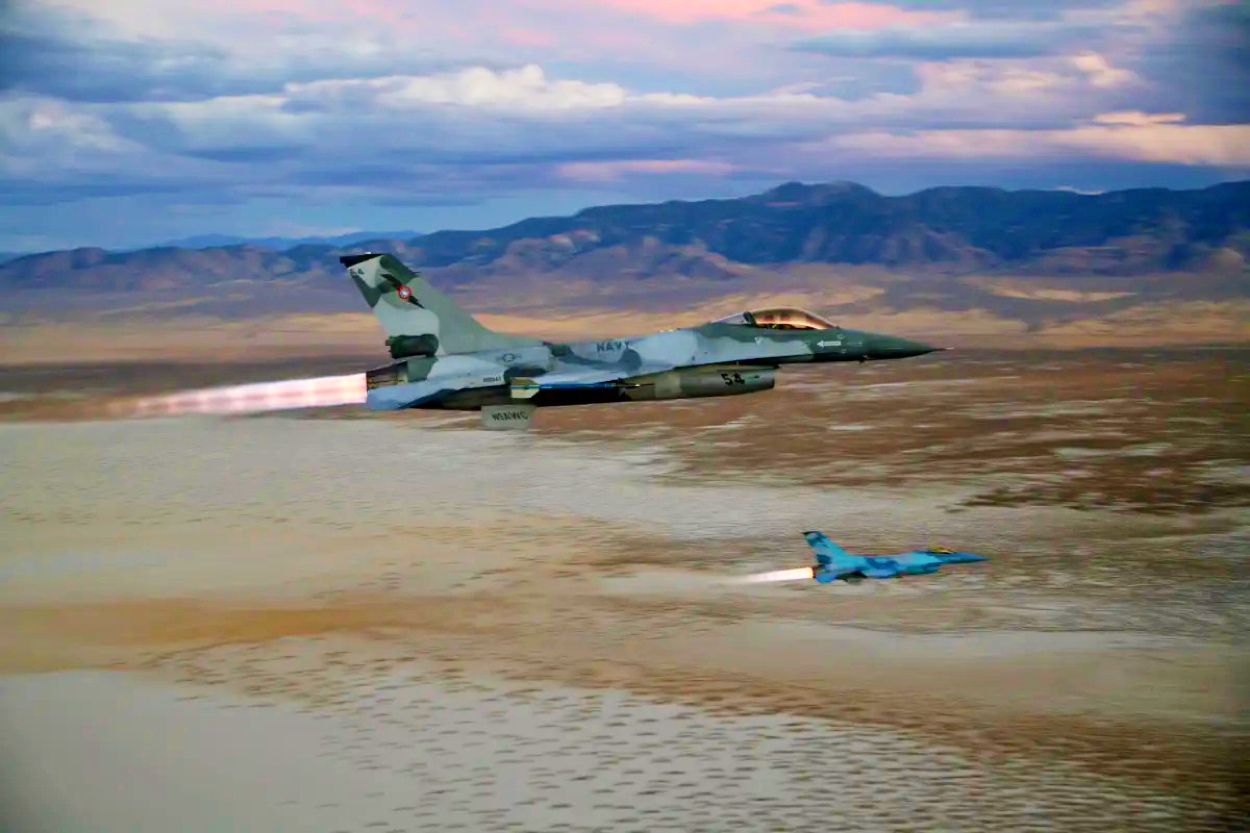Two Russian Aerospace Forces (RuAF) Tupolev Tu-95 strategic bombers were intercepted off Alaska by a US F-16 fighter from an ‘aggressor squadron.’ The sole role of the ‘aggressor squadron’ is to pose and fly as enemy aircraft for aerial combat training.
Interestingly, the F-16 that intercepted the Tu-95 also sported the distinctive paint scheme seen on some units of Russian and Chinese jets like the Su-34, Su-35S, or J-20.
Whether the scramble duty assigned to the ‘aggressor’ F-16 was deliberate or a coincidence is not known. However, given their responsibility to keep abreast of enemy technology and tactics, the latter seems unlikely.
The particular F-16 is a ‘C’ variant (F-16C), belonging to the 18th Aggressor Squadron in Alaska. It was armed with two AIM-120C/D Advanced Medium Range Air-to-Air Missiles (AMRAAM) on the wingtips and two AIM-9L/M/S on the outer pylons.
The Tu-95 stayed over international airspace and did not stray into American skies. This was stated by the Russian Ministry of Defense (RuMoD). The USAF, too, did not complain of an airspace violation.
The US Air Force (USAF) uses F-16s — besides the F-35s — as a part of its “aggressor squadrons,” which pose and simulate enemy aircraft. With Russia and China being the prime military rivals, the units replicate their technology and possible tactics by working closely with the Intelligence Community (IC) to source the latest available information.

The USAF and US Navy ‘aggressor’ F-16s have been assessed to mimic the Su-57, J-20, or the J-10 series in what is also known as “dissimilar combat training” scenarios.
‘Aggressor’ F-16s Intercept ‘Aggressive’ Tu-95s
The RuMoD said that “two Tu-95ms long-range bombers” made a “routine flight over the international waters of the Bering Sea close to the west coast of Alaska.” The Su-30SM fighter aircraft served as the “fighter escort.” In the flight duration that was “more than 11 hours”, the long-range bombers were “escorted by fighter jets of foreign countries” along “certain stages of the route.”
“Long-range aviation pilots regularly fly over the international waters of the Arctic, North Atlantic, Black and Baltic seas, and the Pacific Ocean. Flights of the Russian Aerospace Forces aircraft are carried out in strict compliance with international rules on the use of airspace over international waters,” the RuMoD added.
The official video showed a Tu-95 taking off in dark conditions, most likely midnight or wee hours of the morning. The other Tu-95, too, is seen from the cockpit.
The F-16, with the tail number AK 304, is also seen, along with the distinctive paint scheme. At one point, a Su-35S is also seen behind the F-16. The Su-30SM is armed with what appears to be an RVV-MD short-range air-to-air missile (AAM) on the outer pylon carrier.
Two Tu-95ms long-range bombers make a routine flight over the international waters of the Bering Sea close to the west coast of Alaska.
The flight duration was more than 11 hours. The fighter escort was provided by the crews of the Su-30SM aircraft of the Aerospace Forces. pic.twitter.com/ciHIDC0R91
— EurAsian Times (@THEEURASIATIMES) May 4, 2024
A statement from the North American Aerospace Defense Command (NORAD) said it “detected and tracked four Russian military aircraft operating in the Alaska Air Defense Identification Zone (ADIZ) on May 2, 2024.”
“The Russian aircraft remained in international airspace and did not enter American or Canadian sovereign airspace. This Russian activity in the Alaska ADIZ occurs regularly and is not seen as a threat,” the release added.
USN & USAF Aggressor Squadrons
The USAF has four such units used for ‘red air’ operations. The 65th AGRS that employs F-35As — after flying F-15C/Ds until 2005 — is based at Nellis Air Force Base (AFB) in Nevada, and the 64th, 706th (Nellis) and 18th AGRS (Eielson AFB, Alaska) employs F-16C Vipers.
The USN has used the F-16 Viper since 2002, serving as an “aggressor-training role with simulation capability of current threat aircraft in fighter combat mode.”

The Navy’s Viper fleet, which comprises F-16C/D fighters, replaced F-5N Tiger 2s in 2022 when it received 20 single-seat Block 32 F-16Cs and six two-seat Block 25 F-16Ds from the USAF, as it retired them in line with a divestment scheme that plans to phase out 124 F-16s by 2026. The USAF aims to have more F-16s that are Block 40 and above for its aggressor (AGR) squadrons.
In mid-2023, private defense engineering firm Amentum won a US$818 million contract to maintain and modernize the USN’s ‘aggressor squadrons.’ Amentum will maintain F-16 A/B/C/D aircraft and provide full system maintenance and supply chain support to ensure continuous flight operations and help the USN to grow its F-16 ‘adversary fleet’ across all sites.
- The author can be reached at satamp@gmail.com
- Follow EurAsian Times on Google News




